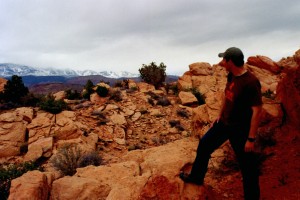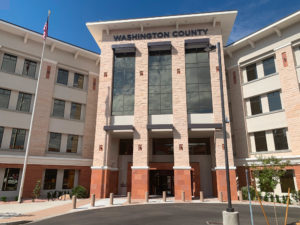Visiting the Reserve
The Red Cliffs Desert Reserve provides many opportunities for recreation and enjoyment. However, direct and indirect impacts to wildlife and plants – trail erosion, trampling of vegetation and delicate soil crusts, and the disruption of animal’s foraging – caused by improper human use can undermine the ecological health of the reserve. It is important that visitors understand and respect the purpose of this protected area.
Please use the reserve responsibly. Remember you are a visitor in someone else’s home.
Rules for Responsible Recreation
Leave What You Find. Collecting plants, wildlife, artifacts, and rocks is prohibited in the reserve. Leave what you find for future generations to discover and enjoy.
Respect Wildlife. View animals from a distance to avoid disturbing them. Tortoises are well camouflaged and may be hard to see, even when they are on the trail. They also come in all sizes, hatchlings are the size of a silver dollar. Watch carefully, especially when temperatures are mild and tortoises are most active. Tortoises are protected by federal law. It is illegal to harass, harm or collect tortoises.
Motorized Vehicles. Motorized vehicles, including motorcycles, all-terrain vehicles, trucks, and automobiles are permitted in the reserve on designated roads only.
 Upland and Lowland Zones. Within the reserve there are a variety of habitats, ranging from lower elevation Mojave desert communities to pinyon-juniper woodlands to rugged slickrock canyons. The biological sensitivity, ecological durability, and resiliency of these habitats also vary. To account for these differences, the reserve has been divided into management zones. Generally, the Upland Zone is less biologically sensitive and more durable; whereas the Lowland Zone is more sensitive to disturbance and easily harmed.
Upland and Lowland Zones. Within the reserve there are a variety of habitats, ranging from lower elevation Mojave desert communities to pinyon-juniper woodlands to rugged slickrock canyons. The biological sensitivity, ecological durability, and resiliency of these habitats also vary. To account for these differences, the reserve has been divided into management zones. Generally, the Upland Zone is less biologically sensitive and more durable; whereas the Lowland Zone is more sensitive to disturbance and easily harmed.
The Upland Zone accommodates recreational users who desire the freedom to responsibly travel off-trail. Hikers and equestrians are free to travel cross-country where the terrain permits, or they may utilize the designated trails within the zone. Camping and campfires are also allowed, with some limitations, in the Upland Zone. However, camping within the Babylon area is limited to the Sand Cove Camping area and by permit only. Please read camping/campfire sections below for more information.
The Lowland Zone protects sensitive species and their habitat by restricting travel to designated trails and by limiting camping and campfires to developed campgrounds. Much of the habitat is delicate, and off-trail travel interrupts fragile ecosystems. For example, cryptobiotic soil, the black “crust” visible on the soils in much of the reserve, is actually a living organism that prevents erosion and increases soil humidity; off-trail travel tramples this crust and leaves soils more susceptible to erosion. In both zones, mountain bikes are required to be on designated trails at all times.
The following are permitted to travel off-trail in the Lowland Zone: 1) those licensed or permitted under state, county, or federal law and regulation are permitted to go off trail east of the Cottonwood Road where necessary to accomplish the purposes for which the license or permit was issued (researchers, educators, hunters); and 2) those performing their official duties (reserve managers, law enforcement officers, emergency personnel).
Trail Etiquette. Shared-use trail systems require that everyone understand and follow simple right-of-way etiquette that is adopted throughout the country:
Horses always have the right-of-way. Hikers and bikers should move to the downhill side of the trail.
Hikers have the right-of-way over everyone except horses
Mountain bikers yield to both horses and hikers. Because they can move quickly and quietly, bikers should warn equestrians and hikers of their presence to avoid startling them.
Pets. All pets must be on a leash to prevent wildlife disturbance and to avoid conflicts with other people. Officers frequently patrol the Reserve and may issue citations when noncompliance is observed. Remember, tortoises are protected by federal law and just as it is illegal for you harass, harm or collect tortoises – the same goes for your pets. Additionally, rattlesnakes and Gila monsters are venomous, and may bite your pet in self-defense. Hunting dogs are allowed to travel off-leash with a licensed hunter in the act of hunting during the official hunting seasons.
Camping. Campgrounds are located at the Red Cliffs Recreation Area and in Snow Canyon State Park. Overnight primitive backpack camping is also permitted in the Upland Zone, except for the Babylon area where it is restricted to the Sand Cove primitive campsite. Campers must obtain a permit issued by the BLM prior to camping at Sand Cove. Please contact the BLM at (435) 688-3200, or Snow Canyon State Park at (435) 801-322-3770 for permits or additional camping information. Remember that officers frequently patrol the Reserve and may issue citations for illegal camping.
Campfires. In the Lowland Zone, campfires are restricted to established fire rings within official campgrounds. Campfires are allowed in the Upland Zone, but may be subject to closures for high fire danger. For this reason, it is recommended to learn what the current campfire status is as you plan your excursion. Wood gathering is prohibited in the Lowland Zone; in the Upland Zone dead and down wood may be collected. Outside official campgrounds, camp stoves are strongly encouraged.
Wilderness Areas. The Red Mountain and Cottonwood Wilderness Areas lie within the Red Cliffs Desert Reserve and Red Cliffs National Conservation Area (NCA); additional management restrictions are enforced within Wilderness Areas. The most noticeable restrictions include the closure of these areas to mountain bikes and motorized access.
Snow Canyon State Park. Snow Canyon State Park is located almost entirely within the boundaries of the reserve, and generally reserve management prescriptions apply to activities inside the park. Within the park, bicycles must stay on paved trails or roads. Other recreational uses are restricted to designated trails, slickrock areas, and designated rock climbing areas. Some park designated trails may not appear on the reserve map. Additional Utah State Parks and Recreation regulations apply, including entrance fees. For comprehensive information regarding Snow Canyon State Park call (435) 628-2255.
Parking. Parking is allowed in designated areas only. Overnight parking for backcountry camping, hunting, or shuttling is permitted. No camping is permitted in the parking areas.
Accessibility. Although the backcountry is rough natural terrain, some areas of the reserve are wheelchair accessible, such as portions of Pioneer Park and Snow Canyon State Park. Paved municipal trails within the reserve also offer an opportunity to enjoy the scenic beauty of the area; currently there is a paved trail along Highway 18. Backcountry trails are protected from motorized access with a 16″-tall “step-over” gate. Horses, hikers and cyclists must step over this gate to enter the reserve.
Check out our Visitor Center!
Still have more questions? Or perhaps you are looking for somewhere to take your kids for a few minutes on a rainy day? Stop by the Red Ciffs Desert Reserve Visitor Center in downtown Saint George. We can suggest a hike, help you plan a day trip, sell you a map, or address any questions or concerns you may have. Don’t forget to take a few minutes to look around the visitor center and check out the animals while you’re there!
